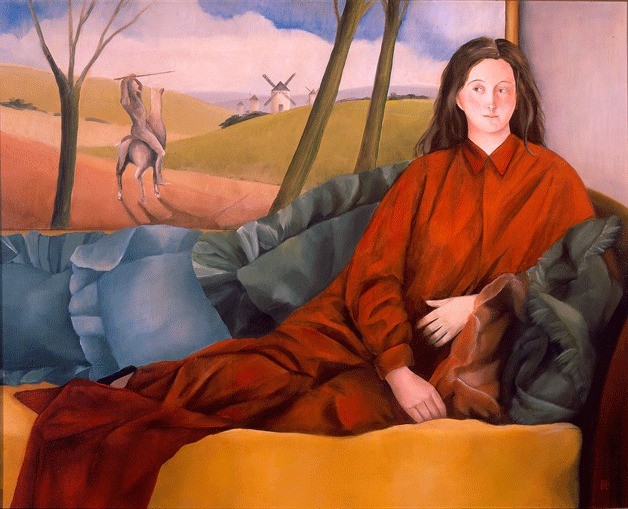Her father was an artist and her mother a beautiful eccentric.
She grew up among the canals, drawbridges and gabled houses of Holland near the sea.
She is Whidbey artist Roojse Penfold, and the fantastic exploits of her life reflect the romantic quality found in many of her paintings.
In her early 20s, Penfold was accepted into an exclusive government-funded Dutch art program for which she produced a number of paintings that were displayed in government-owned buildings, public offices and later sold to whomever wished to collect them privately. Quite a few people, as it turned out.
After about a decade, Penfold found herself in one artistic scenario after another, from the time she spent living on the Canary Islands surrounded by tropical birds, banana plantations, mountains and the ocean, to her stint as a starving mural artist in London, painting a Geoffrey Chaucer mural on the walls of a 17th century banquet hall.
From there she moved to the seaside down of Dorset, where “The French Lieutenant’s Woman” with Meryl Streep was being filmed.
“I had started work on a painting that had promise, that could possibly whisper something, that had an air of healing, bliss, serenity and hope,” Penfold said.
Although she was living an interesting and pleasant life, she felt that something was missing.
“It dawned on me that in order to paint that painting, I first had to change. Goethe said, ‘One must strive to become who one is,’ and that’s what I set out to do. I packed a suitcase, the canvas, brushes and paints and left everything else behind me. It dawned on me what a crazy step I had taken, that I had literally left everything for the promise of a few outlines on a canvas,” she said.
She moved to Cornwall and rented an old rectory called the Rookery, set on the moors of England in a village called Warleggan. The librarian there told her the Rookery was haunted.
Here, Penfold had to walk to the only store a half hour away over the moors, past woods, streams, wild horses and the legendary Dozmary Pool, where legend held that the Lady of the Lake resided, and where King Arthur found Excalibur.
Pretty good material for a painter, and the figurative, vibrant and storied canvases of Penfold reflect many of these legendary places she’s seen.
“If you have all these wishes and desires, things fall into place,” the artist said.
“You have to dare yourself to go down the open road.”
The Rookery turned out to be haunted indeed, but not in bad way, and its former resident, the Reverend Densham, whose ghost it was said still lived in the house, managed to inspire Penfold with various signals — smoke coming off the coils of the stove, or a sudden loud noise in the deeply quiet house. Rather than frighten her to run out the door, these signs gave her the impetus she needed to face her fears and finish her painting, “The Rookery,” that is surprisingly light and dreamlike.
“Strange and scary things would happen, but only when I wasn’t accepting my life or the choice I had made. These ‘hauntings’ scared me into being present, being in the moment, and I knew no harm would come to me,” she said.
Penfold left the Rookery with what she said was a tremendous sense of peace and freedom that gave her the ability to be the artist she knew she wanted to be.
“It was magic. When the painting was finished I left the Rookery. I learned such a great lesson.”
From there she would find herself in one interesting place after another. She would go on to paint in Chicago and San Francisco, where she went to Platt College and learned graphic design. She lived in Budapest and became an illustrator for an ex-patriot newspaper called the Budapest Week, and worked also for the American Chamber of Commerce there on its monthly magazine.
“This seems to be my thing,” Penfold said.
“Things just happen to me. I think you choose to be here — where you are — and you do it and then get out,” she added.
But she’s finally found her place to stay.
Whidbey Island is home for her now, and she has settled into the island’s generous and artistic slow pace. She continues to design through her business, Mind That Bird, where she designs everything from books, brochures, catalogs, labels, logos and posters, to her own whimsical island cards.
Her first card, “From Whidbey Island with Love,” depicts one of Penfold’s fantastical story-pictures of a mermaid on a mussel-laden boat, floating above a grey whale, complete with one of Whidbey poet Judith Adams’ poems inside.
She has also written her first non-fiction book, which she also designed and will self-publish in the coming months. “Learn to Speak Dutch” is Penfold’s guide to casual phrases for the traveler in Holland, with an insider’s edge on what to do and the maps that one needs to find those off-the-beaten-path non-touristic places.
Presently, she is working on a new series of her signature figurative paintings for a show at the Rob Schouten Gallery next year. Her paintings, like the somewhat magical traveling thread of her life, focus on story, myths, fairy tales and, as she said, are loaded with wisdom.
“Paintings are in the moment. I just have to paint,” the artist said.
“It makes me feel good. Everything can be said all in one painting.”
For more info about Penfold’s talents, click here.


